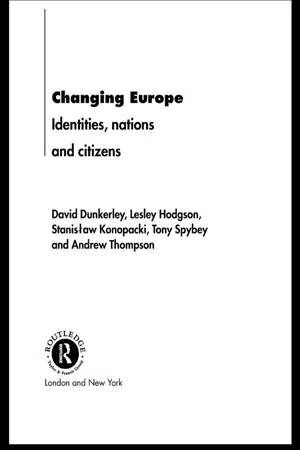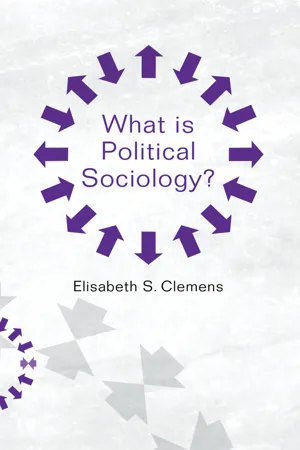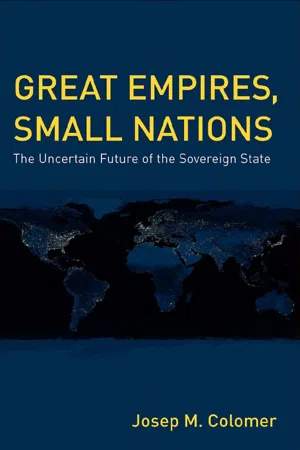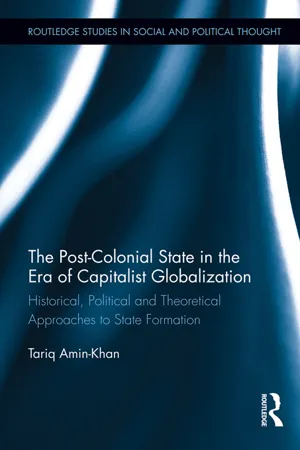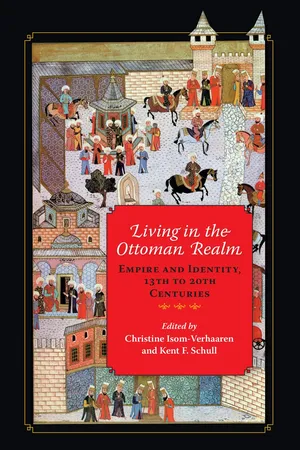History
From Empire to Nation State
"From Empire to Nation State" refers to the transition of political entities from large, multi-ethnic empires to smaller, more homogeneous nation states. This shift occurred primarily in the 19th and 20th centuries and was driven by factors such as nationalism, self-determination, and the decline of imperial power. It led to the formation of modern nation states based on shared language, culture, and identity.
Written by Perlego with AI-assistance
Related key terms
9 Key excerpts on "From Empire to Nation State"
- eBook - ePub
Changing Europe
Identities, Nations and Citizens
- David Dunkerley, Lesley Hodgson, Stanislaw Konopacki, Tony Spybey, Andrew Thompson(Authors)
- 2003(Publication Date)
- Routledge(Publisher)
The situation in the Balkans indicates that the ideal of the nation-state is one which many groups still consider to be worth fighting for. Elsewhere, numerous movements seek independent nation-states, while national governments continue to speak on behalf of ‘the nation’. Thus the idea of the nation-state arguably remains as appealing as it was two centuries ago. It is nevertheless becoming more difficult now for states to pursue the ideal of the cultural nation as they once did. In western Europe governments have increasingly promoted a civic version of the nation-state, in which citizens hold multiple identities; identifying, for example, with their ethnic group, their nation and/or with the wider polity of which they are citizens. This version of the nation-state has become a necessity in countries that have experienced considerable immigration, as well as perhaps increased demands for autonomy from ethnic and national minorities. In these cases governments have had to search for new ways of maintaining the unity of the nation-state. As we will see, however, in other countries the state has become firmly aligned with one ethnic group. For us, the important questions are whether we will see a movement away from the ethnic nation-state in Europe, and, if so, how will ‘the nation’ be defined in this context? Before considering the current and future prospects of the idea of the nation-state, we must understand the routes this idea has taken.The rise and transformation of the nation-state: 1700s to 1945Searching for the origins of the nation-state is something of a red herring; since pure nation-states do not exist, as noted above, it is not possible to identify when they came into being. As we have said, however, the idea of the nation-state has been enormously powerful in European political history, as governments and political movements have sought to convert the theory into practice. What we need to consider, then, is the nation-state as a process, rather than as an entity. We will therefore focus on three processes: the development of the national territory; the transformation of the state; and the building of popular identification with nation and state.Dimensions of change
With regard to territory there are two points we should make. The first is that it is broadly acknowledged that the significance of national frontiers has developed gradually, since the 1648 Treaty of Westphalia. This Treaty ended the Thirty Years’ Wars that had raged across much of Europe. Among the consequences of the Treaty, arguably the most significant was that it established the principle of sovereignty, thus recognising that sovereigns were the sole source of power within their territory and the representative of that territory in foreign affairs.The second point is that since this period the state has come to increasingly occupy the entire national territory. Until the late eighteenth century, and more particularly the latter part of the nineteenth century, the state made little impact on the mass of the population throughout the national territory. Navari (1981) argues that until the French Revolution monarchs made little attempt to effect centralisation throughout their realm. Indeed, she suggests, if they had it is very likely that various interested parties would have resisted such moves. Significant changes began to happen from the late eighteenth century onwards. The cumulative effect of change in post-Westphalian Europe was that the state increasingly came to occupy and, indeed, create - eBook - ePub
- Elisabeth S. Clemens(Author)
- 2016(Publication Date)
- Polity(Publisher)
“States,” in very general terms, can be described as a central set of institutions from which political relations – including authoritative rule-making and control of political violence – extend to cover a territory (Mann 1986: 37). But the arrangement of those political relations can take different forms. Surveying the past few centuries, two different ways of constructing a state have been particularly prominent: empires and nation-states. The key differences between these distinct solutions to the puzzle of how to construct a state can be captured by the relationship between the character of rule (direct or indirect) and its relationship to group membership or identity. Empires rest on extensive relations of indirect rule without a corresponding sense of shared cultural and political membership. “The central state negotiates and maintains more or less distinct compacts between itself and the various segments of this polity” and, as a consequence, “most of the different segments of the polity remain largely unconnected among themselves” resulting in a “hub-and-spoke network structure, where the rim is absent” (Barkey 2008: 9). Thus the Roman Empire encompassed provinces stretching from Mesopotamia to Britain, all linked through the capital city and its official representatives, but not directly to one another.In contrast to this hub-and-spoke imagery, nation-states are closer to what we imagine when looking at a modern map of the world: territorially bounded entities that join a cultural framework of membership – the nation or the people – directly to a system of organized rule. As we will see, this way of thinking about the coincidence of membership, social relations, and political organization is itself the product of the historical emergence of nationalism and the nation-state. It suggests that those contained within national borders share important similarities such as language, cuisine, and even reproductive practices (Watkins 1991; Weber 1978 [1918–20]: 395–8). At the borders between such nation-states, languages change, laws change, money changes, and wars develop. The administration of these differences is a central activity of the government encircled by those boundaries. State officials issue passports, print stamps, and regulate a school curriculum that instills a proper sense of national identity and patriotic fervor in the members of each new generation born within those borders (Brubaker 1996).Both nation-states and empires figure prominently in the development of the contemporary political world. A subset of states, the European powers, extended their reach around the globe through a succession of empires: Portuguese, Spanish, Dutch, British, French, and German. Both Russia and China expanded territorially across Asia in processes of imperial expansion followed by more or less complete incorporation in national configurations. Centered in Istanbul, the Ottoman Empire at its peak encompassed large portions of both Europe and Asia. The Americas were colonized and subdivided by multiple imperial powers – Portuguese, Spanish, French, British and, along a sliver of the Pacific Coast, Russian. The coastlines of Africa were dotted by strongholds of trading empires and, in the nineteenth century, the interior of the continent – or at least its maps – was reorganized by a competitive rush of imperial powers to claim colonial rights over territory. Japan followed a similar model, extending its control through parts of the Western Pacific while, by the late nineteenth century, an ascendant United States would build its own empire in the Pacific and the Caribbean. In all their different forms, these political systems were based on imperialism as a system of indirect rule, “a strategy of political control over foreign lands that does not necessarily involve conquest, occupation, and durable rule by outside invaders” (Steinmetz 2014: 79). - eBook - ePub
Empires
A Historical and Political Sociology
- Krishan Kumar(Author)
- 2020(Publication Date)
- Polity(Publisher)
“We live,” as John Darwin says, “in a world largely made by empires and among ethnic identities as often forged in collaboration with those empires as rallied against them” (2013: 168). It is an understanding frequently lost or distorted in the common habit of pitting nation against empire. Empires make nations, as much as they are, on occasion, opposed by them.Empire Against Nation-State: Divergent Principles
It has been important to show the similarities and overlaps between empires and nation-states because of the persisting tendency to see them as rivals, sworn enemies. Perhaps the strongest underlying feeling, not always made explicit, is that empires are old-fashioned, archaic, part of humanity’s past but not of its present or future. Empires and modernity, it is thought, make awkward bed-fellows. There is no room for empires in the modern world. “This is,” declares Michael Mann (2008: 41, 43), “no longer the age of empires but of nationalism and the nation-state…. Empires are no longer normal.”The preceding account should dispel such an illusion. Empires have been as much a part of modern times as nation-states – arguably, more so. Not only have nations often been made by empires, they have been overseen by them for much of their history. In the twentieth century, empires were the dominant players almost as much as they were in the nineteenth century, supervising, through their directing roles in such organizations as the League of Nations and the United Nations, the emergence and fortunes of nation-states (Mazower 2009a). Nation-states have for much of the time lived in the shadow of empire. Only since the 1960s, perhaps, has it been possible to say that we live in world of nation-states – and, as we have seen, even that statement needs severe qualification.We might go further. Nation-states might seem the norm of the present time. But to many observers, a world of competing nation-states is a recipe for continuing conflict, one that, in the nuclear age, threatens not just the peace but the very existence of humanity. In the wake of the collapse of the “last empire,” the Soviet Union, Charles Maier remarked that “I do believe that we relied on something very like an empire in the postwar period, that it provided an undergirding of peace and prosperity, and that we shall need some equivalent territorial ordering to emerge successfully in the era that has followed 1989” (Maier 2002: 62). - eBook - ePub
- Thomas M. Wilson, Hastings Donnan(Authors)
- 2012(Publication Date)
- Wiley-Blackwell(Publisher)
The great European empires arbitrarily divided the world among themselves on the basis of their capacity for coercion. While national states are predicated on the right of groups to self-determination, there are no agreed international criteria of eligibility for national statehood, nor a consensus on the number of national states that should exist. This enhances the prospects that war and coercion characteristic of imperial expansion will continue to determine the creation, maintenance and elimination of national borders. In practice, the number of national states (and by extension, capital cities) continues to increase dramatically. For example, the original 51 member states of the United Nations in 1945 have now expanded to 192. While there has been a steady growth of member states since 1945, two periods were particularly significant. Between 1956 and 1966 decolonization created 32 new African states, and with the collapse of the Soviet bloc, 15 new states emerged between 1991 and 1993. 6 These accelerated bursts of state formation took place in frontier zones characterized by imperial competition, retreat or collapse. The borders being created, undermined or defended in the process of state and nation formation mark the “caging” of multidimensional economic, political/administrative, cultural or military infrastructural power (Mann 1993). Conflicts over such borders are by definition totalizing and ethnonational. Neither frontier zones nor cities lend themselves easily to such “total” borders, as they are typically characterized by complex specialized and often overlapping borders between diverse jurisdictions and cultural groups. This helps to make them key targets, or arenas of mobilization, for the protagonists of ethnonational conflict - eBook - ePub
Great Empires, Small Nations
The Uncertain Future of the Sovereign State
- Josep M. Colomer(Author)
- 2007(Publication Date)
- Routledge(Publisher)
Part I Empires, states and nations
The numerous and very diverse forms of government that have existed in the history of humankind or currently exist can be grouped into three very general categories: empires, states, and nations. There have always been large empires, increasingly large, in fact, as new transport and communication technologies have developed. Most of the world’s population lives today within these empires. Sovereign states, in contrast, succeeded in Europe within a historical period that began about 300 years ago and is today essentially finished. Finally, small political units with high degrees of autonomy or independence, including ancient and medieval cities and, in modern times, political “nations,” have always been a basic form of collective organization in human history. The main reason for small communities’ persistence is that, on the basis of high levels of social homogeneity, they can adopt soft or democratic forms of government with some ease. As a result of these tendencies, the present world is characterized by the broadness and inclusiveness of a few great empires, the decline or failure of sovereign states, and the flourishing of hundreds of small, politically autonomous or independent communities and nations.Passage contains an image
1 Large empires
The notion of “empire” can account for more than two dozen cases of ancient, medieval, modern, and current experiences of human government. The ancient Chinese and Persian empires, the classical Roman Empire, the colonial empires of Spain, Britain and France, the modern Russia, and the present configurations of the United States of America and of the European Union, among others that are listed in Table 1.1 at the end of this chapter, share important defining characteristics. These can be summarized as follows:- Very large size, in terms of both territory and population.
- Absence of fixed or permanent boundaries
- Tariq Amin-Khan(Author)
- 2012(Publication Date)
- Routledge(Publisher)
1 Context of State Formation Differentiating European Nation-States from Colonial and Post-Colonial States The rise of capitalism, the spread of colonialism, and the creation of the European nation-state stand in stark contrast to the formation of the postcolonial state. Latin American states, which are similar to, yet different from, post-colonial states, are not part of this study, although I refer to these states in this volume. 1 Nonetheless, from the colonial to the postcolonial era, Africa, Asia, and Latin America have taken diametrically dissimilar trajectories of national identity, state, and societal formation compared with Europe and North America. In this chapter, I analyze these differential contexts and related issues in four interrelated sections. First, I provide a historical context for state formation in Europe by foregrounding the capitalism–nation-state nexus—that is, the integral link between the rise of capitalism and the emergence of nationalism and the nation-state in Europe and its transformative drive for Europe’s capitalist development. The capitalism–nation-state nexus was critical, once ethnic groups became politically conscious about nation and nationalism, in breaking up the dynastic realms of the Habsburg, the Romanov, and others and in redrawing the borders of European nation-states. This European developmental path contrasts with the establishment of the colonial state in Africa and Asia at the behest of European colonial rulers. In the second section of this chapter, I show how the link between the rise of industrial capitalism and the emergence of European nation-states changed to the capitalism–imperialism nexus during the period of colonialism beginning in the late 1700s. Since the 1750s, however, the expansion of imperialist Western nation-states, beyond the Americas to Asia and Africa, was in pursuit of captive sources of wealth and raw materials to fuel European capitalist development and expansionism- eBook - ePub
The Postcolonial African State in Transition
Stateness and Modes of Sovereignty
- Amy Niang(Author)
- 2018(Publication Date)
- Rowman & Littlefield International(Publisher)
Naam had the power to literalize itself—in other words, to produce immediate effects as possible cure(s). Conceptually, this difference translated into differentiated narratives—of potency, efficiency and relevance as opposed to uncertain potency, untested power and marginality. This sense of immediacy has always fed state fantasies of (omni)potency, supremacy and hence inevitability. For this reason, statehood was constantly imagined as a superior technology and art.Up until the colonial period, pre-existing forms of political, social and cultural order overlapped and were not always clearly demarcated from each other.I use the idea of the state in transition thus to mean that the process of convergence between state and constituent social units was never fully achieved and was at best fraught with many tensions if not marked by dislocation. The latter takes place ‘where social practices and historical experiences drift apart’ (Lentz 1994, 462). Furthermore, chapter 3 shows how processes of institutional transition also reflect notions of selfhood and subjectivity as a constant work in progress. In other words, the stuff that constitutes people, an ecological milieu, mind, body, memory and anxiety, also informs the ontology of social institutions.The postcolonial nation-state was meant to erase fundamental antagonisms and build a nation out of disparate aspirations and experiences, and it was to do so under a common state framework. In Burkina Faso, former precolonial minorities, under a Mossi system of rule, found in electoral politics a way to experiment with political participation under new terms. On the one hand, they abandoned the ritual codes and signifiers that had sustained a sense of togetherness and self-government vis-à-vis the state. On the other hand, what ceased to make sense under the system of ritual practices was as much the new political configurations as a capacity to (re)constitute relations that were legible. I am not suggesting that one should try to reinvent past modalities but that the recognition of pragmatic limits should not preclude the possibility of extracting, abstracting and adapting their essential components. And people are already doing this in their own way, but in doing so, they also cause various conflicts. - eBook - ePub
Living in the Ottoman Realm
Empire and Identity, 13th to 20th Centuries
- (Author)
- 2016(Publication Date)
- Indiana University Press(Publisher)
IV19TH THROUGH 20TH CENTURIES
Modernity, Mass Politics, and Nationalism: From Empire to Nation-State
THE FINAL CENTURY of the Ottoman Empire’s existence constitutes the last period of major transformation and crisis within the empire resulting from the combination of internal crises, European imperialism, and Ottoman state reforms. In many cases the reforms enacted to save the state facilitated its dismemberment and demise by 1922. In the aftermath of the empire’s defeat at the hands of Russia in 1774 and the occupation of Ottoman Egypt by Napoleon’s forces in 1798, sultans and administrators realized that the empire was no longer the most powerful Eurasian state and was in need of serious reform if it hoped to survive, compete, and thrive in the emerging modern world system of economics and nation-states in which certain European empires constituted its most powerful states. This era, often referred to by scholars as “Modernity,” is the sum total of the changes brought about by a territory’s incorporation into the modern world system through the spread of capitalist market relations and the adoption of new methods of governance and nationalism aimed at centralizing and expanding at unprecedented levels the state’s authority over all facets of society.This era of massive transformation, often referred to as defensive modernization, began in earnest during the reigns of Sultans Selim III and Mahmud II (in total, from 1789 to 1839). This was a period of profound change not only in the Ottoman Empire but throughout the world, especially in Europe. The French Revolution and subsequent Napoleonic Wars greatly affected not only the European balance of power but also the Ottoman Empire’s place within it. During the reign of these two sultans the Ottoman Empire experienced a new wave of imperial restructuring on an unprecedented scale, including attempts to modernize its famed military forces and create a national monarchy. It was also during this period that major nationalist revolts first took place in the empire among its Serbian- and Greek-speaking populations. Also, a push for greater autonomy within the empire by Mehmed Ali Pasha in Egypt and his extensive modernization efforts set a precedent and example for imperial reforms adopted by Ottoman Sultans throughout the rest of the nineteenth century. Ottoman attempts at restructuring the empire and transforming itself on all levels—administratively, fiscally, economically, socially, and politically—into a modern imperial nation-state from 1839 to 1918 met with various levels of accommodation and resistance. These reform programs became increasingly aggressive over the course of the nineteenth century, culminating in the Second Constitutional Period (1908–1918). These reforms should be understood as internally formulated responses to both internal and international factors and not as simplistic Westernization. The overriding goal of these reforms was to preserve the empire through transformation. In so doing, it profoundly altered Ottoman state practice by redefining what it meant to be an Islamic polity. - eBook - ePub
- Anthony Giddens(Author)
- 2013(Publication Date)
- Polity(Publisher)
Post-colonial and modernizing nation-states generally differ from those in categories 1 and 2 in respect of having less linguistic and cultural homogeneity, although this is by no means inevitably the case. The resurgence of local nationalisms within the classical nation-state has served to demonstrate that the ‘colonial’ exploitation of ethnically differentiated groups is not confined to the externally administered territories of the European states. However, in most post-colonial nation-states there is no sense in which a ‘nation’ precedes the emergence of the state and it is not without reason that such states have often been called state-nations. Thus it has been remarked of Black Africa that,though we loosely refer to the recently created countries of that part of Africa as ‘nation-states’, and their peoples as ‘new nations’, it is by no means certain that such formal appelations have any substance. During the run-up to independence, people in the West grew accustomed to regard the anti-colonial movements then coming to power in Africa as variants of the global phenomenon of nationalism . . . However, after some two decades of formal independence, it is not at all clear how far these earlier expressions of nationalistic sentiments have survived to become the basis of state formation. Numerous students of political change in Black Africa today dispute the existence of nation-states in much of the continent.21While I do not think it necessary to question the existence of nation-states in Africa or in other ex-colonial areas, for the states in question are not of the traditional sort, it is obvious enough that their origins and character are mostly quite discrepant from the other types mentioned so far.Post-colonial states – or ‘state-nations’ – are based upon state apparatuses originally established by the colonizing societies. As the above quotation suggests, nationalism has usually played an important part in mobilizing social movements stimulating the transition to independent statehood. But such forms of nationalism have tended to be primarily fostered by elites aspiring to and then holding state power. The consolidation of the administrative power of the state has not been based, as in the classical and colonized types, upon the mobilization of internally generated resources but, rather, upon the ‘imported’ administrative resources brought in from the outside. This has placed the proponents of nationalist symbols in a paradoxical position, sometimes having profoundly schismatic consequences for internal political organization. For nationalist sentiments relate to a myth of origins supplying a psychological focus for the unity of the political community; but any interpretation of origins that has concrete reference to the past is likely to stimulate as much tension as harmony, because of the diversity of cultural differences characteristically involved.
Learn about this page
Index pages curate the most relevant extracts from our library of academic textbooks. They’ve been created using an in-house natural language model (NLM), each adding context and meaning to key research topics.
